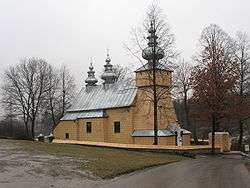Binczarowa
| Binczarowa Rusyn: Білцарьова, Biltsariova Ukrainian: Більцарева, Bil’tsareva | |
|---|---|
| village | |
 Binczarowa | |
| Coordinates: 49°34′N 20°28′E / 49.567°N 20.467°E | |
| Country | Poland |
| Voivodeship | Lesser Poland Voivodeship |
| County | Nowy Sącz |
| Commune | Gmina Grybów |
| Elevation | 597 m (1,961 ft) |
Binczarowa [bʲint͡ʂaˈrɔva] (Rusyn: Білцарьова, Biltsariova; Ukrainian: Більцарева, Bil’tsareva) is a village in southern Poland. It is parallel to the stream known as Binczarce.[1]
History
Binczarowa was first mentioned in Polish history in 1365, in a decree of Casimir the Great, under the name Bibyczareban, which forced the city of Grybow to give up its rights to the surrounding forest.[2] In 1531, the Rusyn Ivan Trukhanovych (Polish: Iwan Truchanowicz) obtained the town and Polish nobility from Sigismund I the Old.[3][4]

After the First Partition of Poland in 1772, it was part of the Galician district of Grybów, and part of the Austro-Hungarian Empire. It was the birthplace of Jaroslav Kacmarcyk (1885-1944), president of the Lemko-Rusyn Republic, and of Metodyj Trochanovskij (1885-1947), who published a Lemko grammar. It was briefly independent from December 5, 1918, until March, 1920, as part of the Lemko-Rusyn Republic (Ruska Narodna Respublika Lemkiu, or Ruska Lemkivska Respublyka).
After World War II, it was depopulated by the Polish government in Operation Vistula in 1947.[5]
Geography
Binczarowa is a Lemko village in the western Lemkivshchyna. It occupies a mountain valley in the Polish commune of Grybów, county of Nowy Sącz, Lesser Poland Voivodeship. It is situated along a stream known as the Binczarce,[1] a tributary of the Poprad. It lies between the towns of Florynka to the east and Bogusza in the west.
Culture and Religion
The town is the site of St. Dymitr's Church, built in 1760. The town is the site of a large World War I cemetery.
References
- 1 2 "Dusza Łemka" [Lemko Soul] (in Polish). Retrieved 22 December 2009.
- ↑ Piekosiński, Franciszek, ed. (1876). Kodeks dyplomatyczny Małopolski/ Codex Diplomaticus Poloniae Minoris [Code of Malopolska] (in Latin). 3. Cracow. OCLC 168884435.
- ↑ "Miesięcznik heraldyczny" [Monthly Heraldic] (in Polish). 1911: 176. OCLC 32011930.
- ↑ Stadnicki, Aleksander (1848). "1531 Bielczarowa". O wsiach tak zwanych wołoskich na północnym stoku Karpat [The so-called Wallachian villages on the northern slopes of the Carpathians] (in Latin and Polish). pp. 88–90. OCLC 234342322.
- ↑ Best, Paul J.; Moklak, Jarosław (2002). The Lemko Region, 1939-1947 : war, occupation and deportation. Cracow, New Haven: Historia Iagellonica Press and Carpatho-Slavic Studies Group.
Coordinates: 49°34′N 20°28′E / 49.567°N 20.467°E